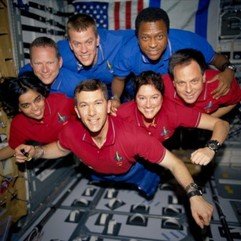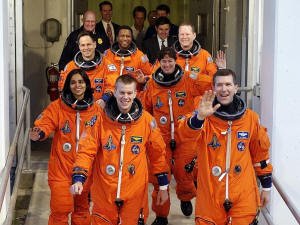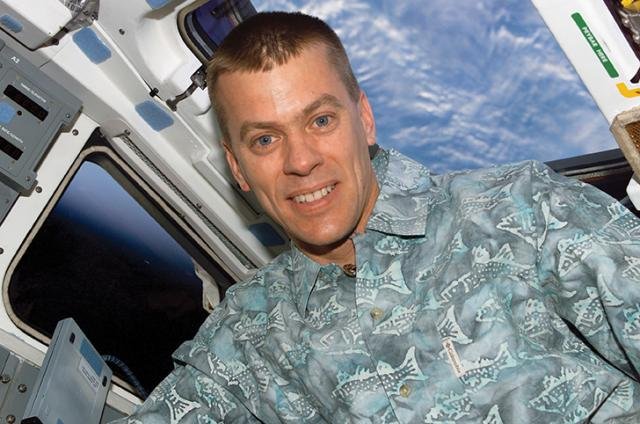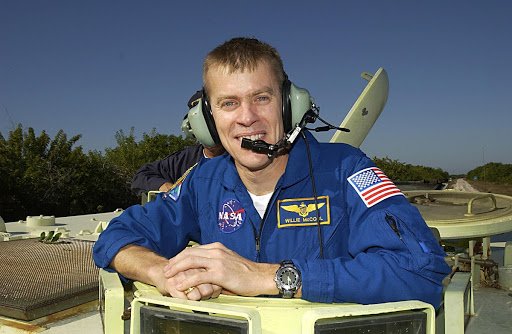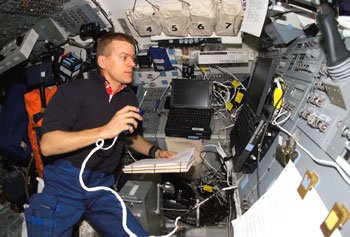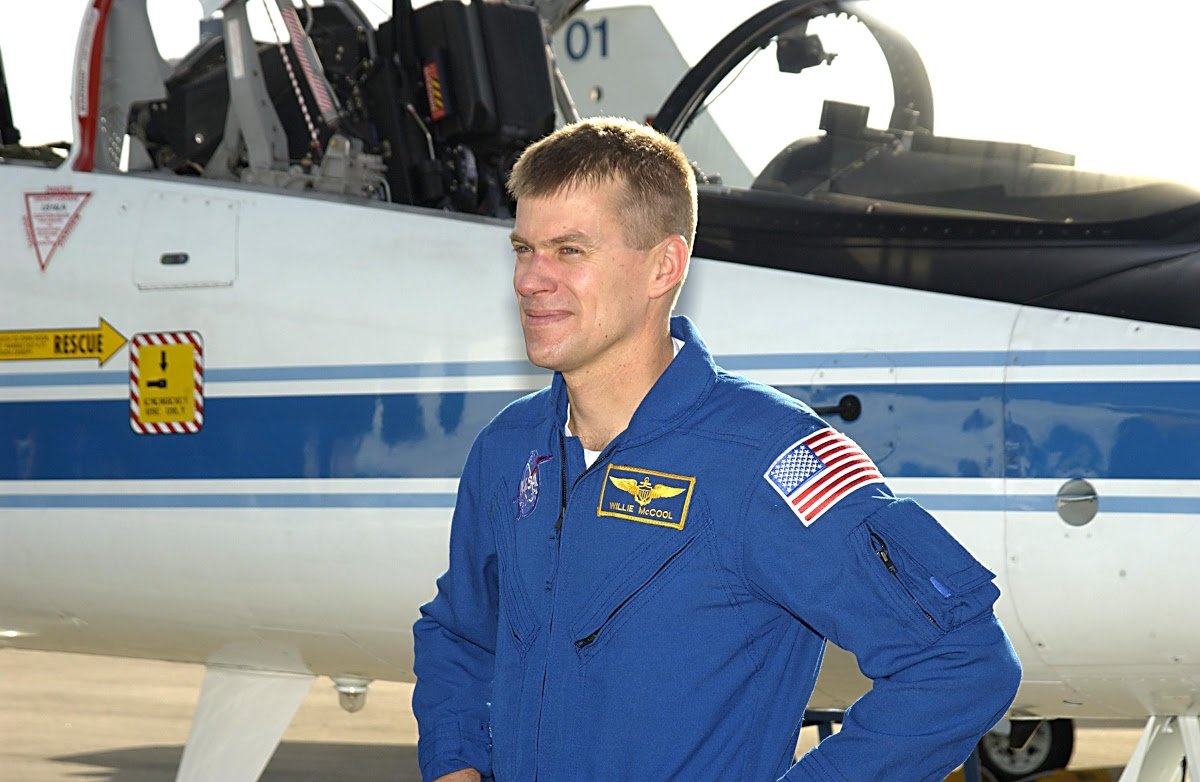William C. McCool
“From our orbital vantage point, we observe an earth without borders, full of peace, beauty and magnificence, and we pray that humanity as a whole can imagine a borderless world as we see it and strive to live as one in peace.”
Early and personal life
McCool was born September 23, 1961, in San Diego, California. His parents divorced when he was young and his mother married Barent McCool, a Naval aviator.[4] McCool was active in the Boy Scouts of America, where he became an Eagle Scout.[5] His favorite song was "Imagine" by John Lennon, which was played during the STS-107 mission. McCool's favorite band was Radiohead, and the song "Fake Plastic Trees" was played by Mission Control as a wake-up call.[6]
McCool died on February 1, 2003, when Space Shuttle Columbia broke up over the southern United States during reentry. He was survived by his wife, Lani, and their three sons. McCool is buried in Anacortes, Washington, where he lived at the time of his death.[2][7]
Education
1976–77: Attended John F. Kennedy High School, Tamuning, Guam[8]
1979: Graduated from Coronado High School, Lubbock, Texas.
1983: Received a Bachelor of Science degree in Applied Science from the United States Naval Academy.[2]
1985: Received a Master of Science degree in Computer Science from the University of Maryland, College Park.[1]
1991: Graduated from United States Naval Test Pilot School, Naval Air Station Patuxent River - Class 101.
1992: Received a Master of Science degree in Aeronautical Engineering from the U.S. Naval Postgraduate School.[1]
Flight experience
McCool completed flight training and was designated a Naval Aviator in August 1986. He was assigned to Tactical Electronic Warfare Squadron 129 (VAQ-129) at NAS Whidbey Island, Washington, for initial EA-6B Prowler training. McCool's first operational tour was with Tactical Electronic Warfare Squadron 133 (VAQ-133), where he made two deployments aboard the aircraft carrier USS Coral Sea to the Mediterranean Sea and received designation as a wing-qualified landing signal officer (LSO). In November 1989, McCool was selected for the U.S. Naval Postgraduate School/Test Pilot School (TPS) Cooperative Education Program.[1]
After graduating from TPS in June 1992, McCool worked as a TA-4J and EA-6B test pilot in Flight Systems Department of Strike Aircraft Test Directorate at NAS Patuxent River, Maryland. He was responsible for the management and conduct of a wide variety of projects, ranging from airframe fatigue life studies to numerous avionics upgrades. However, McCool's primary efforts were dedicated to flight test of the Advanced Capability (ADVCAP) EA-6B. Following his Patuxent River tour, McCool returned to Whidbey Island, and was assigned to Tactical Electronic Warfare Squadron 132 (VAQ-132) aboard the carrier USS Enterprise. He served as Administrative and Operations Officer with the squadron through their work-up cycle, receiving notice of his NASA selection while embarked on Enterprise for her final pre-deployment at sea period.[1]
McCool accumulated over 2,800 hours flight experience in 24 aircraft and over 400 carrier arrestments.[4]
NASA experience
Selected by NASA in April 1996, McCool reported to the Johnson Space Center the following August.[4] He completed two years of training and evaluation, and was qualified for flight assignment as a pilot. Initially assigned to the Computer Support Branch, McCool also served as technical assistant to the director of flight crew operations, and worked Shuttle cockpit upgrade issues for the Astronaut Office.[1]
Spaceflight experience
McCool was pilot of Space Shuttle mission STS-107, January 16 to February 1, 2003, logging 15 days, 22 hours and 20 minutes in space. The 16-day flight was a dedicated science and research mission. Working 24 hours a day, in two alternating shifts, the crew successfully conducted approximately 80 experiments. According to NASA, McCool said of the unique view he and his crewmates had from Columbia:[9][10]
From our orbital vantage point, we observe an earth without borders, full of peace, beauty and magnificence, and we pray that humanity as a whole can imagine a borderless world as we see it and strive to live as one in peace.
— William Cameron McCool, 29 January 2003 onboard Columbia
STS-107's mission ended abruptly on February 1, 2003, when Columbia disintegrated during re-entry, 16 minutes before scheduled landing. All seven crew members were killed.
McCool was posthumously awarded the NASA Space Flight Medal, the NASA Distinguished Service Medal, the Defense Distinguished Service Medal (DDSM), and the Congressional Space Medal of Honor.[1]
Organizations
U.S. Naval Academy Alumni Association
Special honors
Served as team captain of the U.S. Naval Academy Cross Country team his senior year
Graduated second of 1,083 in the Class of 1983 at the U.S. Naval Academy
Presented "Outstanding Student" and "Best DT-II Thesis" awards as graduate of U.S. Naval Test Pilot School, Class 101[4]
Awarded Navy Commendation Medal (2)[4]
Awarded Navy Achievement Medal (2)[4]
Tributes
Asteroid 51829 Williemccool was posthumously named for McCool.[12]
Lunar crater McCool is named after him.[13]
McCool Hill in the Columbia Hills on Mars was posthumously named for McCool.[14]
McCool Hall, in the Columbia Village apartments at the Florida Institute of Technology, is named after him.[15]
Guam South Elementary/Middle School, a DoDEA school in Santa Rita, Guam, was renamed CDR William C. McCool Elementary/Middle School on August 29, 2003.[16]
Willie McCool Track and Field at Coronado High School in Lubbock, Texas, was posthumously named for McCool.[17]
Willie McCool Memorial with Bronze Sculpture was dedicated on Saturday, May 7, 2005, at Huneke Park at 82nd and Quaker Avenue in Lubbock, Texas.[17]
Commander William C. McCool Academy, opened in the fall of 2020, is a STEM middle school in Lubbock Texas[18][19]
The William McCool Science Center, located on the campus of the Frank Lamping Elementary School in Henderson, Nevada, is a facility where elementary students throughout the Clark County School District have an opportunity to learn about space and other fields of science.[20]
A Gawad Kalinga village in Moncada, Tarlac, Philippines, will be named "USN Commander Willie McCool GK Village".[21]
In the Star Trek book Mirror Universe – Glass Empires, the shuttlecraft of the U.S.S. Defiant in the short story "Age of the Empress" is named the McCool.
McCool Track at the Naval Academy Preparatory School, Naval Station Newport, Rhode Island is named after him.[17]
The spacefaring game Elite: Dangerous contains a starport in the Jaroua system named "McCool City".
The Willie McCool Monument was dedicated on December 2, 2007, at the U.S. Naval Academy Golf Course. The monument stands where Willie would have been 16 minutes from the finish line during his fastest race on Navy's home course.
The Willie McCool Memorial Model Air Field park located in North Las Vegas, Nevada was posthumously named for McCool on October 23, 2004.[22]
McCool Hall, located on Tinker AFB, Oklahoma is a Navy Bachelors Enlisted Quarters named after McCool.[17]
Camp McCool, located in Bagram Airfield, was the home of rotating EA-6B Prowler Squadrons supporting ISAF in Afghanistan.[23]
The FAA named a Fix/Waypoint MCCUL near Naval Air Station Whidbey Island (also near Anacortes, WA) located at 48 13.11N, 123 07.03W. Navy pilots are routinely vectored to the McCool waypoint.
The McCool Breakthrough Award is named after Willie McCool and is given to an individual who has made a significant breakthrough in the spirit of ICHRIE's mission.[24]
The Commander William C. McCool Academy is Lubbock ISD’s newest magnet middle school.[25]
About Space Shuttle Columbia
Space Shuttle Columbia (OV-102) was a Space Shuttle orbiter manufactured by Rockwell International and operated by NASA. Named after the first American ship to circumnavigate the upper North American Pacific coast and the female personification of the United States, Columbia was the first of five Space Shuttle orbiters to fly in space, debuting the Space Shuttle launch vehicle on its maiden flight in April 1981. As only the second full-scale orbiter to be manufactured after the Approach and Landing Test vehicle Enterprise, Columbia retained unique features indicative of its experimental design compared to later orbiters, such as test instrumentation and distinctive black chines. In addition to a heavier fuselage and the retention of an internal airlock throughout its lifetime, these made Columbia the heaviest of the five spacefaring orbiters; around 1,000 kilograms (2,200 pounds) heavier than Challenger and 3,600 kilograms (7,900 pounds) heavier than Endeavour. Columbia also carried ejection seats based on those from the SR-71 during its first six flights until 1983, and from 1986 onwards carried an imaging pod on its vertical stabilizer.
During its 22 years of operation, Columbia was flown on 28 missions in the Space Shuttle program, spending over 300 days in space and completing over 4,000 orbits around Earth. While it was seldom used after completing its objective of testing the Space Shuttle system, and its heavier mass and internal airlock made it less than ideal for planned Shuttle-Centaur launches and dockings with space stations, it nonetheless proved useful as a workhorse for scientific research in orbit following the loss of Challenger in 1986. Columbia was used for eleven of the fifteen flights of Spacelab laboratories, all four United States Microgravity Payload missions, and the only flight of Spacehab's Research Double Module. The Extended Duration Orbiter pallet was used by the orbiter in thirteen of the pallet's fourteen flights, which aided lengthy stays in orbit for scientific and technological research missions. Columbia was also used to retrieve the Long Duration Exposure Facility and deploy the Chandra observatory, and also carried into space the first female commander of an American spaceflight mission, the first ESA astronaut, the first female astronaut of Indian origin, and the first Israeli astronaut.
At the end of its final flight in February 2003, Columbia disintegrated upon reentry, killing the seven-member crew of STS-107 and destroying most of the scientific payloads aboard. The Columbia Accident Investigation Board convened shortly afterwards concluded that damage sustained to the orbiter's left wing during the launch of STS-107 fatally compromised the vehicle's thermal protection system. The loss of Columbia and its crew led to a refocusing of NASA's human exploration programs and led to the establishment of the Constellation program in 2005 and the eventual retirement of the Space Shuttle program in 2011. Numerous memorials and dedications were made to honor the crew following the disaster; the Columbia Memorial Space Center was opened as a national memorial for the accident, and the Columbia Hills in Mars' Gusev crater, which the Spirit rover explored, were named after the crew. The majority of Columbia's recovered remains are stored at the Kennedy Space Center's Vehicle Assembly Building, though some pieces are on public display at the nearby Visitor Complex.


